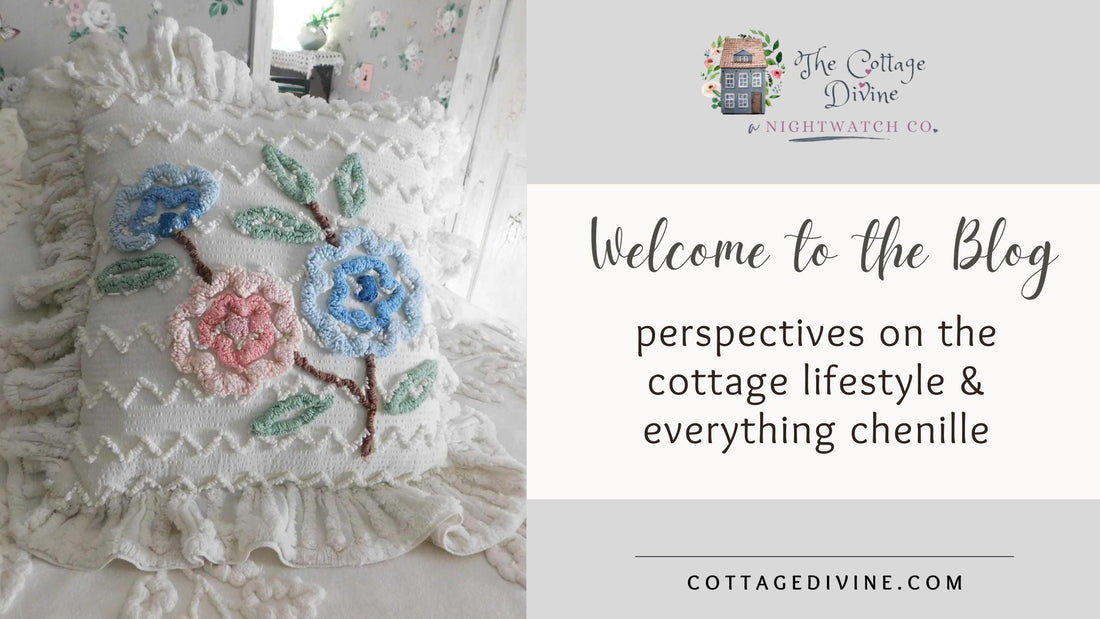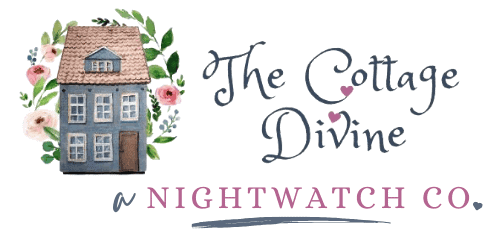
Vintage Chenille Bedspread Value Guide: Uncovering Hidden Treasures in Your Linen Closet
Share
There's something utterly enchanting about running your fingers across the soft, textured surface of a vintage chenille bedspread. These beloved textile treasures have graced American bedrooms for decades, and today they're experiencing a strong renaissance among collectors and cottage-style enthusiasts.
Whether you've inherited your grandma's cherished bedspread or discovered one at a local estate sale, understanding its value can help you appreciate both its monetary worth and historical significance.
Chenille bedspreads represent many facets of American life. It seems like each little tuft brings together long-lost stories of American textile craftsmanship, of family traditions, of simpler times in our history. And each highlights the evolution of home décor trends that span from the 1930s right up to today.
Understanding Chenille: A Brief History
The word "chenille" comes from the French word for caterpillar, aptly describing the fuzzy, segmented appearance of chenille yarn. American chenille bedspread production flourished primarily in the Southeastern United States, with Georgia becoming the undisputed capital of chenille manufacturing. Towns like Dalton gained fame as the "Tufted Textile Capital of the World," where skilled artisans created these beloved household staples.
During the Great Depression and World War II era, chenille bedspreads became symbols of hope and domesticity. Families treasured these affordable luxuries that could transform a simple bedroom into a welcoming sanctuary. The golden age of chenille production lasted from the 1930s through the 1950s, when mass production techniques made these beautiful textiles accessible to middle-class American families.
Key Factors That Determine Value
Age and Era of Production
Vintage chenille bedspreads typically fall into three distinct periods, each with different value ranges:
Pre-1940s Hand-Tufted Spreads command the highest prices, often ranging from $150 to $500 or more for exceptional pieces. These early examples feature hand-cut chenille yarn and demonstrate superior craftsmanship with intricate patterns and dense tufting.
1940s-1950s Golden Age Production represents the sweet spot for collectors, with values typically ranging from $75 to $300. This era produced the most recognizable patterns and highest quality mass-produced pieces that balance affordability with excellent craftsmanship.
1960s-1970s Later Production generally values between $25 to $100, as synthetic materials and simplified manufacturing processes became more common during this period.
Pattern Complexity and Rarity
The intricacy and uniqueness of patterns significantly impact value. Floral motifs reign supreme in the chenille world, with roses being particularly coveted. Large, elaborate rose patterns with multiple colors and dimensional petals often command premium prices. Geometric patterns, while beautiful, typically hold moderate values, whereas simple or sparse designs usually represent the most affordable options.
Rare patterns or those produced in limited quantities can dramatically increase value. Regional patterns specific to certain manufacturers or time periods often attract serious collectors willing to pay premium prices.
Size and Completeness
Full-size bedspreads designed for double or queen beds generally hold higher values than twin or throw sizes. However, matching sets including pillowcases or shams can significantly boost overall worth. Complete bedroom ensembles with matching curtains or other accessories represent the holy grail for collectors and can command exceptional prices.
Condition Assessment
Condition plays a crucial role in determining value, and learning to properly assess wear can mean the difference between a treasure and a disappointment.
Excellent Condition pieces show minimal signs of use with bright, unfaded colors, intact tufting, and no stains or holes. These premium examples command top dollar in their respective categories.
Good Condition spreads may show light wear, slight fading, or minor pulls but maintain structural integrity and visual appeal. These pieces typically sell for 60-75% of excellent condition values.
Fair Condition items display noticeable wear, fading, or small repairs but remain usable and displayable. Values usually drop to 40-50% of excellent condition prices.
Poor Condition spreads with significant damage, extensive staining, or major repairs have limited value except as craft materials or for parts to restore better examples.
Manufacturer and Origin
Certain manufacturers developed reputations for superior quality and distinctive styling. Georgia Tufted Textiles, Cabin Crafts, and other southeastern producers created some of the most sought-after examples. Hand-signed or labeled pieces from known manufacturers can carry premium values, especially among dedicated collectors who prize documented provenance.
Popular Patterns and Their Values
Floral Designs
Rose patterns dominate the most valuable category, with large, multi-colored blooms commanding highest prices. Cabbage roses, tea roses, and stylized floral bouquets from the 1940s-1950s era regularly sell for $150-400 in excellent condition. Smaller floral motifs or single-color designs typically range from $75-200.
Peacock and Bird Patterns
These dramatic designs featuring peacocks, swans, or other birds create stunning visual impact and attract dedicated collectors. Values generally range from $125-350, with peacock patterns commanding premium prices due to their bold colors and intricate detail work.
Geometric and Abstract Patterns
Art Deco-influenced geometric designs from the 1930s-1940s appeal to modern décor enthusiasts and typically value between $100-275. Later abstract patterns from the 1950s-1960s generally range from $50-150.
Holiday and Themed Patterns
Christmas, Easter, or other holiday-themed chenille spreads represent specialty collecting areas. These seasonal pieces often command premium prices from holiday décor enthusiasts, typically ranging from $100-300 depending on the holiday and rarity.
Authentication and Dating Tips
Learning to authenticate and date vintage chenille bedspreads helps ensure you're getting genuine vintage pieces rather than modern reproductions.
Examine the yarn construction closely. Authentic vintage chenille features cotton backing with characteristic fuzzy tufts created by cutting looped yarn. The texture should feel substantial but not overly stiff. Modern reproductions often use different synthetic materials that feel different to the touch.
Check for period-appropriate labels, tags, or care instructions. Vintage pieces may retain original retail tags, manufacturer labels, or care instruction cards that help establish authenticity and date of production.
Study the color palette and dye quality. Vintage chenille often features distinctive color combinations that reflect the aesthetic preferences of their era. Colors should appear naturally aged rather than artificially distressed.
Where to Buy and Sell
Estate Sales and Auctions
Estate sales represent prime hunting grounds for vintage chenille discoveries. Arrive early for the best selection, and don't hesitate to ask about items that might be stored away. Local auction houses sometimes feature textile collections that include exceptional chenille pieces.
Antique Shops and Vintage Stores
Specialized textile dealers and vintage home décor shops often carry curated selections of chenille bedspreads. While prices may be higher than estate sales, you benefit from expert knowledge and often better condition pieces.
Online Marketplaces
Platforms like eBay, Etsy, and specialized vintage textile sites offer vast selections but require careful attention to condition descriptions and return policies. Always ask for additional photos and condition details before purchasing.
Specialty Textile Shows
Regional textile and quilt shows sometimes feature chenille dealers and collectors. These events provide opportunities to see multiple examples side-by-side and learn from experienced collectors.
Care and Preservation
Proper care preserves both the beauty and value of vintage chenille bedspreads. Always hand wash or use gentle machine cycles with cold water and mild detergent. Avoid harsh chemicals, bleach, or fabric softeners that can damage fibers or fade colors.
Air dry whenever possible, as heat from dryers can shrink cotton backing or damage delicate tufting. Store flat or carefully folded with acid-free tissue paper to prevent permanent creases.
For display purposes, rotate pieces periodically to prevent uneven fading from sunlight exposure. Consider professional cleaning for valuable or severely soiled pieces.
Investment Potential and Market Trends
The vintage chenille market has shown steady growth over the past decade, driven by renewed interest in cottage-core aesthetics, sustainable home décor choices, and appreciation for handcrafted textiles. Quality pieces in excellent condition tend to hold their value well, while exceptional examples continue to appreciate.
Current market trends favor authentic pieces with documented provenance, complete sets with matching accessories, and rare patterns from recognized manufacturers. The growing interest in sustainable and vintage home décor suggests continued strength in the chenille collecting market.
However, like all collectibles, values can fluctuate based on fashion trends, economic conditions, and changing collector preferences. Focus on pieces you genuinely love and will enjoy using or displaying, rather than purely speculative investments.
Conclusion
Vintage chenille bedspreads offer a unique combination of historical significance, artistic beauty, and practical functionality that continues to captivate collectors and home décor enthusiasts. Understanding the factors that influence value – age, pattern complexity, condition, size, and manufacturer – empowers you to make informed decisions whether buying or selling these textile treasures.
Remember that beyond monetary value, each vintage chenille bedspread carries stories of the families who cherished them, the craftspeople who created them, and the era they represent. Whether you're furnishing a cottage-style bedroom, building a textile collection, or preserving family heirlooms, these remarkable pieces continue to bring warmth and beauty to our homes just as they did for previous generations.
Take time to appreciate the artistry and craftsmanship evident in every tuft and pattern. In our fast-paced, mass-produced world, vintage chenille bedspreads remind us of a time when everyday household items were created with care, attention to detail, and an eye for lasting beauty that transcends changing fashions.
